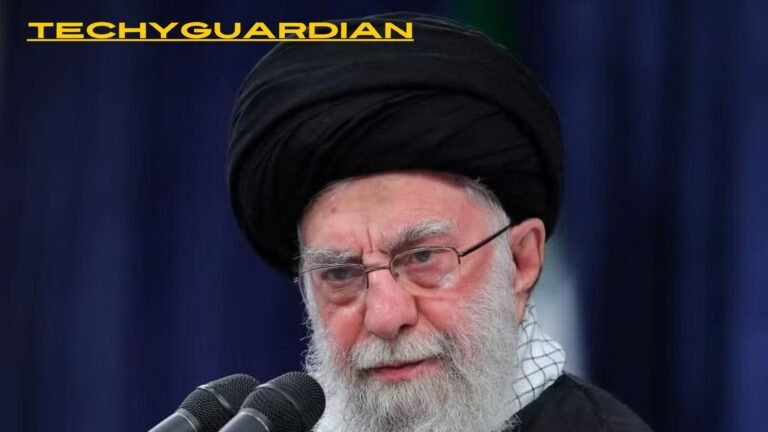
Iran's Supreme Leader, Ayatollah Ali Khamenei
Iran’s Supreme Leader, Ayatollah Ali Khamenei, recently made a powerful and symbolic appearance during a sermon, holding a rifle by his side. This act not only captured the attention of millions but also sent a resounding message both within Iran and to the international community. As the most influential figure in the Iranian political and religious landscape, Khamenei’s actions and statements are constantly scrutinized, and this particular moment has sparked intense discussions across various platforms.
Symbolism Behind Khamenei’s Gesture
The image of Ali Khamenei holding a rifle during a sermon is laden with symbolism. Iran has a long history of associating religious leadership with military power, dating back to the 1979 Islamic Revolution. The presence of the rifle suggests a message of resistance and defense, particularly in the face of increasing external pressures, including sanctions and political challenges from Western countries.
The rifle, often seen as a symbol of revolution and steadfastness, represents Iran’s ongoing struggle against what it perceives as foreign interference in its domestic affairs. For Khamenei, this gesture likely serves to reaffirm Iran’s commitment to self-reliance and its readiness to defend its sovereignty. His audience, both domestic and international, would recognize this as a visual declaration of Iran’s enduring resistance against global powers, especially the United States and Israel.
Historical Context: Religious Leadership and Military Power in Iran
To fully grasp the gravity of Khamenei’s display, one must understand the historical relationship between religious authority and military power in Iran. Since the Islamic Revolution of 1979, Iran’s leadership has blended religion with military strength, a fusion exemplified by the Islamic Revolutionary Guard Corps (IRGC). Ayatollah Ali Khamenei, as the Supreme Leader, oversees both the spiritual and military realms of the country, making his association with a rifle during a sermon even more significant.
The IRGC was established after the revolution to protect the Islamic system and to prevent foreign influence. The presence of military symbolism in religious sermons underscores the inseparable bond between faith and defense in Iranian political ideology. For decades, this duality has shaped Iran’s domestic policies and its stance on foreign relations, with Khamenei at the helm, guiding both theological and strategic military decisions.
International Reactions to Khamenei’s Gesture
The global reaction to Ayatollah Ali Khamenei rifle display has been mixed. In the West, particularly in the United States and Europe, the image has been interpreted as a provocative gesture, possibly heightening tensions surrounding Iran’s nuclear ambitions and its role in regional conflicts. Many analysts view this move as a sign that Iran is prepared to take a hardline stance in any negotiations or diplomatic efforts aimed at curbing its influence in the Middle East.
Conversely, within Iran and among its allies, this image may resonate as a symbol of strength and defiance. For countries and groups sympathetic to Iran’s resistance against Western hegemony, Khamenei’s rifle becomes a badge of honor, reinforcing the perception of Iran as a bulwark against oppression and foreign domination.
Impact on Iran’s Relations with Regional Neighbors
Khamenei’s act of holding a rifle during his sermon may also influence Iran’s relations with its regional neighbors. Countries like Saudi Arabia and Israel, long-standing rivals of Iran, might interpret this gesture as an indication of Iran’s continued willingness to engage in power struggles over influence in the Middle East. The symbolism of the rifle could fuel existing tensions, particularly in war-torn areas such as Syria and Yemen, where Iran has supported proxy forces.
However, Iran’s allies, including Syria, Hezbollah in Lebanon, and Shia militias in Iraq, are likely to see Khamenei’s stance as an affirmation of Iran’s support for their causes. The rifle, in this context, becomes a token of reassurance that Iran remains committed to backing its allies in their struggles against common enemies, further solidifying its leadership in the region.
Domestic Implications: Rallying Nationalistic Sentiment
Domestically, the image of Ayatollah Ali Khamenei with a rifle serves to rally nationalist and religious fervor among his followers. In times of economic hardship, particularly under the weight of U.S. sanctions, such gestures from the Supreme Leader aim to solidify public support for the regime. Khamenei’s message is clear: despite external pressures, Iran will remain steadfast and will not capitulate to foreign demands.
The rhetoric of resistance has long been a staple of Khamenei’s leadership, and this public display of military symbolism reinforces that narrative. By invoking the imagery of defense and revolution, Khamenei taps into the deeply ingrained ethos of self-reliance and national pride among many Iranians.
Religious Significance of the Sermon Setting
In addition to the political and military implications, the religious setting of the sermon plays a critical role in understanding the full impact of Khamenei’s actions. Sermons in Iran, particularly those delivered by the Supreme Leader, are not just religious gatherings; they are political platforms from which Khamenei communicates key messages to the nation and the world. The mosque, traditionally a place of peace and reflection, becomes a stage for asserting Iran’s resolve in the face of adversity.
Khamenei’s combination of religious authority and military symbolism in this setting underscores the theocratic nature of Iran’s leadership, where religious and political duties are inseparable. By bringing a rifle into this sacred space, Khamenei is blending spiritual leadership with the idea of perpetual resistance, a theme that resonates strongly with the principles of the Islamic Republic.
Conclusion: The Broader Implications of Khamenei’s Rifle Symbolism
In summary, Ayatollah Ali Khamenei’s gesture of holding a rifle during a sermon transcends the act itself, representing a profound statement of Iran’s resilience, both domestically and internationally. It reflects a long-standing tradition where military power and religious authority are intertwined, symbolizing the country’s readiness to defend itself against foreign threats. The image has provoked diverse reactions from across the globe, with some seeing it as a threat, while others interpret it as a sign of strength and defiance.
The implications of this act will likely reverberate through Iran’s domestic policy, foreign relations, and its ongoing struggles on the international stage. As Khamenei continues to guide the nation, his symbolic use of military imagery will undoubtedly remain a powerful tool for rallying support, both within Iran and among its allies abroad.






2 thoughts on “Iran’s supreme leader Ali Khamenei holds rifle by side for sermon”